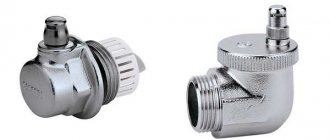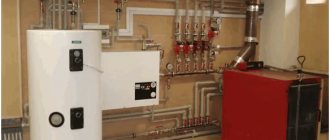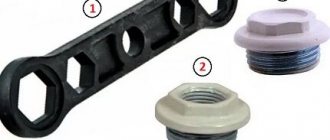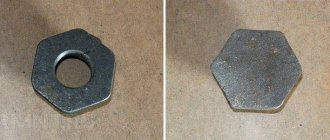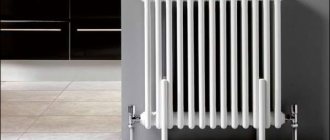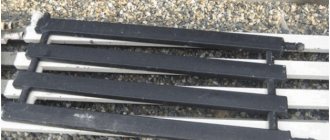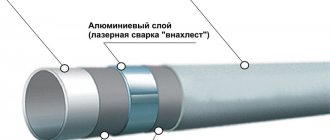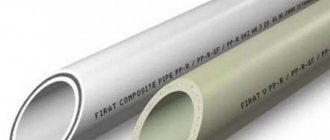Everyone who uses water heating is well aware of the trouble of airing the system, and if with autonomy this issue is easier to solve, then for centralized systems it is much more difficult, but in any case, installing a Mayevsky tap on a cast iron radiator helps a lot.
In fact, this valve is used for various water batteries, such as sectional, tubular and panel ones, made of cast iron, steel, aluminum and bimetal - air space can accumulate in any of them, so its etching is sometimes the first necessity to ensure complete heating premises. But you will find out about everything in small details below, and you can also watch the video in this article.
Where is the Mayevsky crane installed?
Air bubbles have much less weight than water, and therefore accumulate at the peak points of the heating circuit. In these cases, water may not fill the pipes quickly enough, there were voids in the system, and the water itself may contain large amounts of dissolved oxygen.
Possible situations for using the structure:
- The use of a Mayevsky crane should be resorted to when, at normal temperatures on the boiler, the pipes are unable to warm up the area covered.
- You should also pay attention if one section of the heating pipe remains cold, in contrast to neighboring areas.
- The consequences of improper operation of the heating system include noise during coolant circulation.
- Vibration of pipes, which, as the airlock increases, becomes more and more noticeable to home owners.
If the air lock is not eliminated in time, the inner surface of the pipes and radiators will corrode, which will require an immediate replacement of the heating system.
Rules of service
Uninterrupted operation of the drain valve is possible only if the rules for its operation are observed:
- To bleed air, open the tap. If the air flow does not stop after a few minutes, it means that there is an additional suction in the system. To check the tightness, take a thin sheet of paper and pass it around all the joints. In places where there is suction, the sheet will be drawn to the joint.
- If the exhaust channel is dirty, clean it with a thin needle or wire.
- With infrequent use, the faucet becomes corroded and stops working. To correct the situation, treat the faucet with WD-40. For preventive purposes, after the end of the season, the threads should be treated with silicone grease.
- The faucet cannot be repaired and must be replaced if broken. Dismantling must be done using an auxiliary adjustable wrench to fix the radiator cap. Otherwise, the radiator itself may be damaged.
Design of the Mayevsky crane
The familiar Mayevsky crane has been known for a long time, and has not changed its shape and design since its creation. This device has the following components:
- Frame.
- Cone-shaped screw with a head. The head shape is designed specifically for the turnkey.
- Another mandatory element is the rotating part.
The device of a classic hand-held product also includes two channels for moving air from the system. How the Mayevsky crane works:
- The start of the crane operation is initiated by the launch of the rotating part. Previously, turning was done manually with a screwdriver.
- Today, the design of the crane provides for the presence of an external key, which operates this device.
The price for a Mayevsky crane (for a manual model) ranges from 40 to 150 rubles.
Installation of "Mayevsky" on a cast iron battery
Installation of drain valves on the liners of aluminum and steel radiators is quite simple and does not require a detailed description. The valve with the rubber ring is carefully tightened with a small force of the key, then the nylon cap is turned in the desired direction. A valve with a wide plastic ring and a hole in a metal body is immediately fixed in the required position - with the outlet fitting downwards.
Another thing is installing a valve in a cast iron radiator plug of type MS-140. Some craftsmen make a homemade faucet - drill the fitting, cut a thread and screw in a simple bolt. The option is extremely primitive and inconvenient - when the bolt is loosened and the air is released, an uncontrolled leak will form.
How to install Mayevsky correctly without unscrewing the stuck fitting:
- Buy an old-style faucet with an M10 x 1 landing thread and be sure to prepare the appropriate taps - numbers one and two. The so-called machine tap will not work - cast iron is too hard, the tool will simply break.
- Empty the heater and drill out the top plug first with a thin drill bit, e.g. Ø5 mm.
- Carefully break the hole with a Ø9 mm drill, then chamfer it to ensure the tool fits in securely.
- Cut the thread by alternately passing the hole with taps No. 1 and 2. Check how well the valve is screwed in.
- Having sealed the threads with flax, tighten and tighten the tap with medium force.
Advice. Drilling cast iron and cutting threads should not be done “dry”. Be sure to lubricate the tool with machine oil, otherwise the working edge will quickly become dull.
An easier way is to replace the standard liner with a new one, with a ready-made hole for the “air vent”. In this case, a modern valve with an external thread G½” (15 mm) is used. The main thing is to successfully unscrew the old battery plug. How to install “Mayevsky” on the MS-140 radiator, watch the video:
Types of cranes based on operating principle
The production of sanitary products does not stand still, and therefore the Mayevsky faucet now has an automatic analogue. The development of automatic taps is associated with a shortage of free space in residential premises.
In this case, pipes and radiators are placed in the most inaccessible places. For such situations, an automatic tap is used, which independently opens the valve under the influence of excess pressure.
Design features
The design of the crane is quite simple. It consists of a body with a calibrated thin hole and a locking screw with a conical head screwed into it. The housing has a hole for air to escape outside.
The outer end of the locking screw can be designed as:
- slotted head for a screwdriver;
- square head for a special key;
- thumb-type handles for unscrewing the screw by hand.
Some designs have a separate air collection chamber inside the housing with an opening for air outlet.
The outside of the housing has a standard thread for installing the tap into the radiator hole instead of a plug (plug).
READ ALSO: Which cast iron heating radiators are better, and why
Design of the Mayevsky crane
To bleed air, the shut-off screw is unscrewed half a turn (or a full turn). This opens a calibration hole through which air from the radiator first enters the hole in the valve body and then exits out.
After complete removal of air, the shut-off screw must be tightened until it stops.
Types of taps by material of manufacture
In addition to the principle of operation, all Mayevsky cranes differ depending on the material used. Both metal and plastic models are extremely popular in practice.
The most famous cranes include:
- Steel products. This alloy is made by combining iron and carbon, and sometimes several other impurities. Such cranes are characterized by increased strength, low weight, and easy maintenance requirements.
- Brass, from which mechanical Mayevsky taps are most often made. This material has a high degree of resistance to corrosion and can serve for a long time without deterioration. In addition, this alloy is absolutely safe for others, for residents of a house or apartment.
- Taps made of cast iron. Cast iron has sufficient strength that allows you to use the product for a long time in everyday life. The main disadvantage is the very significant weight of the product, which creates additional load on the fastenings of the heating pipes.
Sometimes in apartments you can find a plastic tap installed on heating radiators. This model has low cost, but low strength.
Accidental damage to the structure is possible when the valves are opened excessively or when cleaning the outlet from dirt. Therefore, plastic products will have to be changed quite often.
Questions and answers
If the tap was not on the riser (or it was the first shut-off device after the riser) and was installed without approval, then the owner is responsible for it, according to Art. 210 of the Civil Code of the Russian Federation.
Installing a faucet only helps remove air. If the battery is not connected correctly (this happens with a top connection) or is clogged, this procedure most likely will not help.
A special seal is responsible for the tightness of the valve, and wear may be the cause of the leak. In this case, you will need to replace the seal or the entire valve. If drops occur in the thread area, the tap must be tightened with a wrench for a tighter fit. The leak may be due to a blockage.
If the heating system is working properly and there is enough coolant inside, the reason is that the tap hole is clogged. It needs to be cleaned or the tap replaced.
Installing a Mayevsky crane on a heating system significantly simplifies its operation and increases operating efficiency.
The installation process is not complicated and can easily be done with your own hands. But selecting the appropriate valve model requires the use of some knowledge, so it is better to consult with specialists. During operation, it is important to follow the rules and periodically carry out preventive maintenance to maintain the functionality of the mechanism.
Features of operation of a mechanical crane
The Mayevsky tap is usually located at the end of the battery or radiator. To normalize the operation of the heating system, you should use the instructions on how to bleed air using a Mayevsky tap:
- The tap is opened using a key or screwdriver.
- Air valves start in a clockwise direction and close in the opposite direction.
- As soon as the characteristic hissing (sometimes whistling) stops, the tap can be closed.
- A separate situation is when a forced coolant circulation pump is installed in the heating system. Before bleeding the air, turn off the pump and wait up to 5 minutes. In this case, the movement of the coolant will completely stop, and the air plug will rise to the upper tier of the radiator.
- The hole intended for bleeding air may become clogged with dirt. Don't worry, dirt can be quickly removed with a needle or pin.
The operation of the Mayevsky crane for cast iron pipes deserves special attention. Such heating systems are very dirty, so the owner will have to frequently clean the tap outlet. It is also worth abandoning the automatic crane model in such a situation.
Scope of application and types of cranes
Mayevsky manual valves are used for the following purposes:
- First of all, removing air bubbles from heating radiators of all types - aluminum, steel and cast iron.
- Venting air from heated towel rails.
- Periodic de-airing of problem areas of the heating network - expansion joints turned upward, bypass loops (for example, above the front door), risers and other places where air accumulates.
Installation of air bleed valves is provided by all manufacturers of modern radiators. Heating devices are supplied from the factory with fittings (plugs) with a hole for the Mayevsky valve. The battery valve is selected according to the diameter of the external pipe thread - G¼”, ½”, ¾”.
Reference. The G¼” external thread of the air valve is identical to that of a standard pressure gauge.
If you need to organize air bleed in a problem area of the system, buy a Soviet-style valve with an external metric thread M10 x 1. The pipe wall is drilled with a Ø9 mm drill, the thread is cut with a tap, then a Mayevsky valve is screwed in and the joint is sealed with plumbing flax.
Another option is to cut a tee into the main line and install a slotted valve on the outlet pipe, as done in the photo below. The method will help with a cold (air-filled) heated towel rail that does not have a thread for an air vent.
Some models of heated towel rails have a slot for an air vent (photo on the left)
The operating principle of all Mayevsky valves is the same, but commercially available products may differ in design:
- The shut-off valve is made for a slotted screwdriver, a special key, or equipped with a handle. The old version of the product uses a hex head bolt.
- The needle (cone) that covers the hole can be metal or plastic.
- The corresponding “aged” valves shown in the photo are installed on designer cast-iron batteries.
Faucets with a handle are convenient to use - the air can be easily released without any tools. On the other hand, anyone can turn the valve, including small children, which should not be allowed. Hence the recommendation - buy and install traditional products with a slot or a tetrahedral key.
Retro-style valves for designer batteries (left) and a small 1/4-inch “air vent” for a ball valve (right)
Reference. Manufacturers equip some models of ball valves with Mayevsky air vents. Here the option with a handle is more appropriate, and the valve with a G¼” thread can be removed and replaced with a pressure gauge or a plug can be installed.
Do not confuse “Mayevskie” with automatic float-type air vents. The latter are similar in principle of operation - the passage hole is also closed with a needle, but air is removed without human intervention. There are 2 types of such devices - universal (used in boiler safety groups) and radiator ones.
Valves for automatic air release - radiator and universal
Features of operation of an automatic crane
Automatic models are very convenient in private homes, where cast iron pipes have been replaced with more modern plastic products. Such structures do not have serious contamination, and therefore are not capable of disrupting the operation of the crane.
- Inside the automatic device there is a chamber equipped with a float. The float is connected to a needle valve located at the top of the housing.
- As soon as the air lock creates pressure above the specified limit, the valve is activated and opens, freeing the air channel.
- As soon as the pressure in the heating system decreases, the valve closes due to the float.
This feature prevents water or coolant from leaking from the system.
Automatic Mayevsky cranes are very convenient for practical use, but they are more expensive than mechanical models.
Technical parameters of the Mayevsky valve
The air outlet device is designed for one function - removing gaseous mixtures from the heating circuit. Therefore, it does not have as many characteristics as other products. For classic cast iron batteries, the invention of B.B. is considered the most effective. Mayevsky - a faucet with a manual needle valve. It has been used since the 30s of the twentieth century.
Installation of a modern type of crane
Today, several varieties of this device for removing air from heating equipment are produced:
- classic model with external thread for installation;
- as an additional element for equipping radiators with a plastic cap;
- combined type devices with a ball valve included in the shut-off valve kit.
Most types of shut-off valves work with any liquid medium, but there are blocks only for drinking water. But not all valves are adapted to work with the release of air, steam or gas under high pressure. A tightly screwed rod should tightly seal the collector hole. Most air vents can withstand pressures of about 10 atm.
Important! For shut-off valves, the tightness class is important; according to GOST 9544-93 this is class A (a product without visible leaks).
Mayevsky taps of any modification do an excellent job of their functions when combined with cast iron radiators. Most often they are made of brass, less often - of steel. The devices are designed for ambient temperatures ranging from 100 – 120°C; there are more resistant models that work with steam under pressure when the coolant is heated to 140 – 150ºC.
The type of product, its maximum load and compliance with the type of communications are reflected in the documentation attached to the model, so it is important to carefully study the instructions. For example, indicate the type of thread (external and internal) - ½ inch, one or ¾ inch. The marking may indicate a thread pitch of 1 mm - this is M10x1.
The simplest valve design:
- brass body;
- needle duct screw;
- cap;
- seal.
The design of the crane is very simple
In urban heating systems that supply entire neighborhoods, automatic air vents are provided. There are other methods for preventing air jams, which are carried out by engineers and communications specialists.
Photo of Mayevsky crane
Where does the air come from in the system?
Air locks inside the heating system inevitably appear in the following cases:
- when a new heating system is being installed;
- in case of repair of the system and removal of water from it;
- when installing new radiators;
- when air is sucked into the system during its operation;
- when there is a gradual release of air bubbles from the water, which is a natural physical phenomenon;
- in the presence of corrosive processes, which are accompanied by the release of a certain amount of air. Aluminum heating radiators are especially susceptible to such processes in city apartments.
Installation procedure
The easiest way to install a flanged ball valve is a very popular design. To install such a faucet, you must:
- Choose a suitable location.
- Wrap the threads of the tap with a sealant, for example, FUM tape.
- Screw on the tap.
- Check connections for leaks.
When figuring out how to properly install a tap on a battery, you should take into account a number of nuances that will help you perform these operations correctly. For example, if the faucet is embedded into an already finished system, you should cut out a small part of the pipe and cut a suitable thread, if one is missing. You can see more useful information on installation in the video:
Of course, before starting work you will need to remove the coolant from the heating system. Owners of private houses with individual heating will not have any problems, but apartment residents will have to coordinate this event with the management company.
The ball valve is installed in the area between the battery and the bypass - a special jumper that ensures coolant circulation in the system, even when the valve is closed
The tap is installed in front of the battery and behind the jumper that connects the “input” and “output” of the coolant, so that when the flow is blocked, the coolant does not stop circulating through the system. If such a jumper (professionals call it a bypass) is missing, this problem must be solved when installing the tap on the radiator. When installing a faucet, you should consider two points:
- There must be no obstruction to the adjustment knob when set to any position.
- The user should have free access to the tap.
Before purchasing a faucet, of course, you should make sure that the diameter of the faucet and the pipe on which it will be installed match each other. It is also worth clarifying the type of thread. For a flanged valve, these elements can be configured as follows:
- both threads are internal;
- both threads are external;
- combination of internal and external threads on different sides.
Flange valves have a special marking in the form of an arrow, which indicates the direction of flow of the working medium, i.e. coolant. Do not neglect these instructions when installing the faucet.
To avoid leaks, FUM tape or other suitable sealant should be used correctly. In the case when the tap is installed on a pipe with an open thread (it is clear that the tap flange will have a closed thread), the seal is wound clockwise. In this case, the master is positioned facing the pipe opening. If the open thread is on the flange, the seal is also wound clockwise, but facing the tap, and not the pipe.
When the FUM tape is wound correctly and in sufficient quantity, noticeable efforts will be required to screw the thread. Upon completion of the work, part of the seal may protrude slightly at the joint; this is a completely normal situation, characteristic of good sealing. If the tap turns easily, too thin a layer of sealant was used. In this case, you should wind a little more FUM tape, and then screw the tap tightly to the pipe. Following these simple rules will help you install the faucet correctly and ensure a sufficiently high seal.
At the end of the work, it is necessary to check the connection by filling the system with water, preferably at high pressure. Neglecting this rule can lead to flooding of the room due to improper sealing of connections. Most often, residents of apartment buildings suffer from the consequences of unscrupulous work, since filling the heating system with water before the start of the heating season is usually carried out without warning on a weekday.
Rules for using the product
The Mayevsky crane must be used correctly. To work with the mechanism, place a container under the radiator and place a dry cloth. Using a key, the screw is turned in the desired direction. After this, air begins to be released from the installation, and then water begins to flow. It is important to wait until the liquid begins to flow without interruption.
If the system has pumps, they must be disconnected ten minutes before the process before releasing air. After the heating season, the adjustment screw is treated with a special silicone lubricant. This will protect the threads from the action of the coolant. If there is a need to replace the tap, then select adjustable wrenches. Hold the radiator with one key and unscrew the tap with the other.
Air vent in a polypropylene pipe system
If you provide proper care, timely maintenance and cleaning, the device will last a long time and will not cause problems.
Types of taps on heating radiators
We install ball valves, cone valves, thermostatic valves and any others. For plumbers from San Remo, there is no task that they cannot handle. Ball valves are not suitable for regulating the coolant flow, but they are convenient for shutting it off (for example, in case of battery replacement).
Cone taps can be used to turn off the water or regulate the heating intensity. The most convenient to use are shut-off devices with a thermal head (so-called thermostats). They allow you to automatically maintain the temperature manually set by the user.
